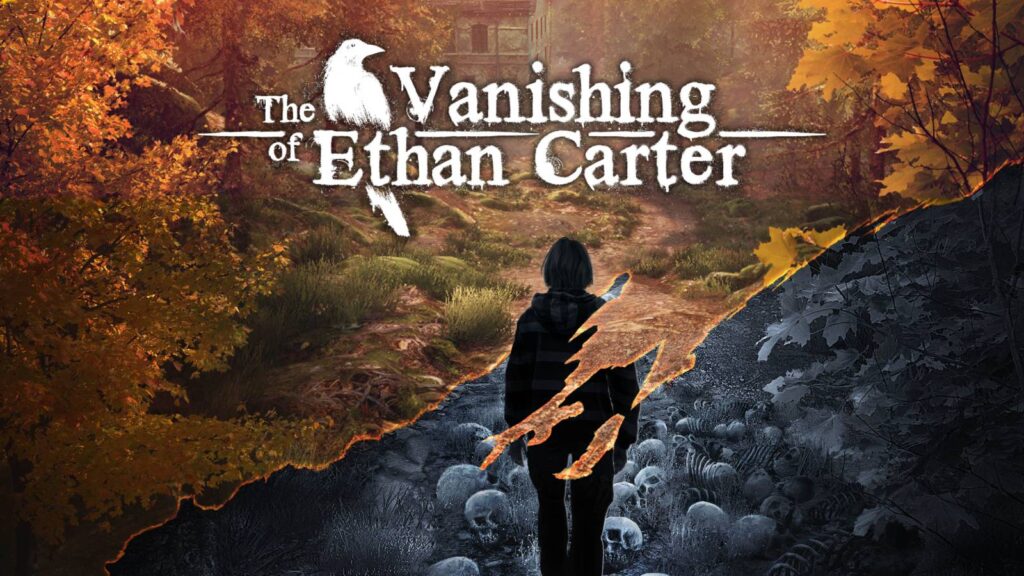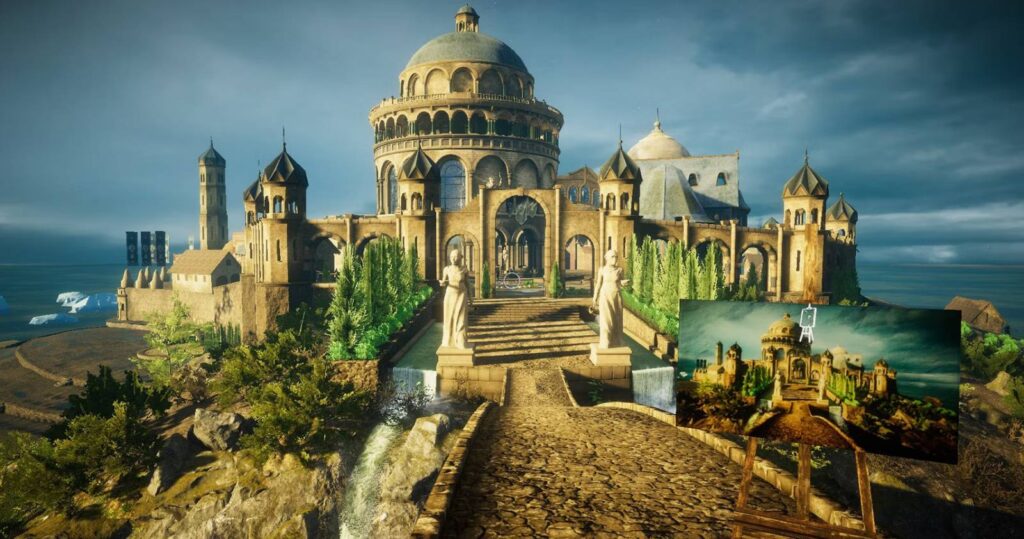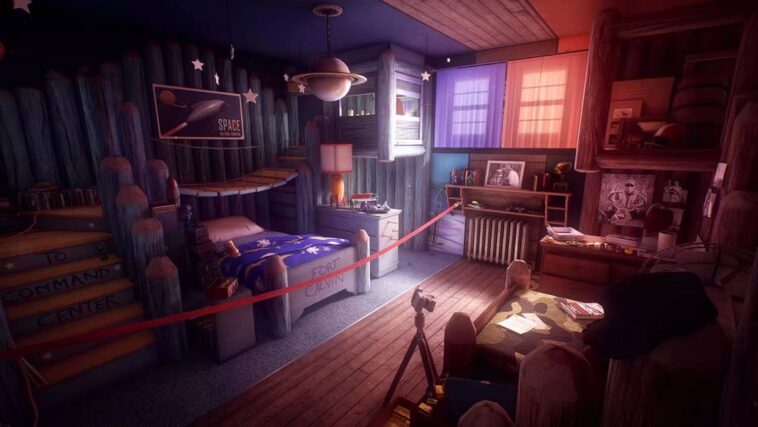Table of Contents
Introduction
Why What Remains of Edith Finch is a Masterpiece
“What Remains of Edith Finch” is not just a game; it’s an emotional journey that takes you through the lives of the Finch family. Developed by Giant Sparrow and published by Annapurna Interactive, this walking simulator has set a new standard for storytelling in video games.
Its unique narrative structure, where each family member’s story is a mini-game in itself, has captivated players and critics alike. The game has garnered numerous awards, including the BAFTA for Best Game in 2018.
Its storytelling prowess lies in its ability to make you feel a part of the Finch family, to experience their joys, sorrows, and inevitable tragedies. The game’s narrative is so compelling that it transcends the medium, making you forget you’re playing a game at all.
The Rise of the Walking Simulator Genre
Walking simulators have come a long way from being the underdogs of the gaming world. They’ve carved a niche for themselves, offering players a break from action-packed, fast-paced gaming experiences.
These games focus on storytelling, atmosphere, and emotional engagement, providing a unique experience that’s akin to interactive storytelling.
Titles like “Gone Home,” “Firewatch,” and “The Vanishing of Ethan Carter” have paved the way for this genre, each offering a unique take on what a walking simulator can be.
What Makes a Game Similar to What Remains of Edith Finch?
So, what exactly are we looking for in games like “What Remains of Edith Finch”? First and foremost, a strong narrative. The story should be compelling enough to keep you hooked from start to finish. Secondly, the atmosphere.
The game should be able to transport you to another world, whether it’s a haunted house, a serene forest, or a post-apocalyptic city. Finally, emotional engagement. The game should make you feel something, whether it’s joy, sorrow, or even fear.
Games Like What Remains of Edith Finch
1. The Unfinished Swan: A Journey Through a Painted World
Developer: Giant Sparrow
Publisher: Annapurna Interactive
Release Date: October 23, 2012
Platforms: PlayStation 3, PlayStation 4, PlayStation Vita, Windows, iOS
The Story
“The Unfinished Swan” is another masterpiece from Giant Sparrow, the same studio that brought us “What Remains of Edith Finch.” The game follows a young boy named Monroe, who is chasing after a swan that has escaped from an unfinished painting.
As Monroe, you find yourself in a completely white space, armed with nothing but balls of black paint. As you throw these paintballs, the world around you comes to life, revealing its hidden structures and pathways.
Gameplay Mechanics
The gameplay mechanics are as unique as the story itself. The game starts with a blank canvas, and it’s up to you to reveal the world around you. This mechanic is not just a gimmick; it’s integral to the game’s puzzles and exploration.
As you progress, new gameplay elements are introduced, such as water that helps plants grow, creating new pathways for you to explore.
Emotional Impact
What sets “The Unfinished Swan” apart is its emotional depth. The game is not just about chasing a swan; it’s about Monroe’s journey to come to terms with the loss of his mother. Each chapter reveals more about their relationship, making the game an emotional rollercoaster.
User Reviews
Players have praised “The Unfinished Swan” for its innovative gameplay and emotional storytelling. One user review states, “The game took me on an emotional journey that I wasn’t expecting. The story is touching, and the gameplay is unlike anything I’ve ever experienced.”
2. Gone Home: The Darling of the Walking-Sim Genre

Developer: Fullbright
Publisher: Fullbright
Release Date: August 15, 2013
Platforms: Windows, macOS, Linux, PlayStation 4, Xbox One, Nintendo Switch, iOS
The Story
“Gone Home” is a pioneer in the walking simulator genre, setting the stage for many games that followed. The game takes place in a mansion in Oregon, where you play as Kaitlin Greenbriar, a young woman who has just returned from overseas.
The house is empty, and your family is missing. As you explore the house, you uncover clues that reveal the emotional and complex stories of your family members.
Gameplay Mechanics
Unlike traditional games that focus on combat or puzzle-solving, “Gone Home” relies solely on exploration and narrative. The game has no enemies, no puzzles, and no challenges other than piecing together the story.
This might sound dull to some, but the game’s strength lies in its ability to tell a compelling story through environmental cues—letters, photographs, and even mundane household items.
Emotional Impact
The emotional impact of “Gone Home” is profound. As you delve deeper into the lives of the Greenbriar family, you can’t help but feel a sense of intimacy and emotional investment. The game touches on themes of love, identity, and the complexities of family dynamics, making it a deeply moving experience.
User Reviews
The game has received critical acclaim for its storytelling and emotional depth. One user review encapsulates this sentiment well: “Gone Home is more than a game; it’s an experience that touched me on a deeply personal level. It’s a shining example of what video games can achieve narratively.”
Also featured in: Top 15 Games Like Life Is Strange You Just Can’t Miss!
3. The Vanishing of Ethan Carter: A Darker Narrative

Developer: The Astronauts
Publisher: The Astronauts
Release Date: September 25, 2014
Platforms: Windows, PlayStation 4, Xbox One, Nintendo Switch
The Story
“The Vanishing of Ethan Carter” is a first-person mystery game that leans more towards the darker side of storytelling. You play as Paul Prospero, a detective with supernatural abilities, who receives a letter from a young boy named Ethan Carter. Intrigued, you travel to Red Creek Valley to find that Ethan has vanished under mysterious circumstances.
Gameplay Mechanics
The game employs a unique mechanic called “Retrospective” where you can visualize the sequence of events that led to a particular outcome. This mechanic is crucial for solving the game’s various mysteries.
Unlike “What Remains of Edith Finch” and “Gone Home,” this game has a more traditional puzzle-solving element, making it a bit more challenging.
Emotional Impact
The game is a dark, emotional journey into the human psyche. It explores themes of loss, guilt, and the complexities of human emotion. The supernatural elements add a layer of intrigue, but the real horror comes from the emotional revelations.
User Reviews
“The Vanishing of Ethan Carter” has been praised for its atmospheric storytelling and intricate puzzles. A user review states, “The game masterfully blends narrative and gameplay, creating an experience that is both challenging and emotionally engaging.”
4. Firewatch: A Tale of Connection in a Lonely Place

Developer: Campo Santo
Publisher: Campo Santo, Panic
Release Date: February 9, 2016
Platforms: Windows, macOS, Linux, PlayStation 4, Xbox One, Nintendo Switch
The Story
Set in the Wyoming wilderness, “Firewatch” places you in the shoes of Henry, a fire lookout assigned to watch for smoke in Shoshone National Forest. However, this is not just a game about forest fires; it’s a game about human connection.
Your only contact is with your supervisor, Delilah, whom you never meet but communicate with via walkie-talkie. The game explores the complexities of their relationship against the backdrop of a mysterious occurrence in the forest.
Gameplay Mechanics
“Firewatch” is a first-person adventure game that combines exploration with narrative. The gameplay is straightforward, focusing on navigation and dialogue choices. The choices you make in your conversations with Delilah affect the storyline, adding a layer of depth to the game.
Emotional Impact
The emotional core of “Firewatch” lies in the relationship between Henry and Delilah. Both characters are flawed, relatable, and deeply human. The game explores themes of loneliness, the need for human connection, and the ways we cope with personal tragedies.
User Reviews
The game has been lauded for its compelling narrative and emotional depth. One user review mentioned, “Firewatch is a hauntingly beautiful game that stays with you long after you’ve finished it. The emotional weight of the characters’ interactions is something rarely seen in video games.”
5. Everybody’s Gone to the Rapture: A Slow-Paced Atmospheric Narrative

Developer: The Chinese Room
Publisher: Sony Computer Entertainment, Playism
Release Date: August 11, 2015
Platforms: PlayStation 4, Windows
The Story
“Everybody’s Gone to the Rapture” is set in a small English village that is eerily deserted. You’re left to explore and piece together what happened to its inhabitants. The game is a spiritual successor to “Dear Esther,” also developed by The Chinese Room, and it takes the concept of environmental storytelling to a new level.
Gameplay Mechanics
The game is a first-person exploration game where the primary mechanic is walking. Yes, walking. But don’t let the slow pace fool you; the game is rich in narrative depth. As you explore, you’ll encounter floating orbs of light that trigger audio snippets, revealing the stories of the missing villagers.
Emotional Impact
The game delves into the lives, relationships, and tragedies of the villagers, making it a deeply emotional experience. The slow pace allows you to absorb every detail, adding to the emotional weight of the narrative.
User Reviews
The game has received mixed reviews, but those who appreciate the genre praise its emotional storytelling. One user review states, “It’s a game that requires patience, but your patience is rewarded with a deeply emotional and thought-provoking experience.”
6. Tacoma: A Futuristic Tale Aboard an Abandoned Space Station

Developer: Fullbright
Publisher: Fullbright
Release Date: August 2, 2017
Platforms: Windows, macOS, Linux, PlayStation 4, Xbox One, Nintendo Switch
The Story
“Tacoma” takes the walking simulator genre to space, quite literally. Set in the year 2088 aboard the Tacoma space station, you play as Amy Ferrier, a contractor sent to recover data from the station’s AI.
What makes “Tacoma” unique is how it tells its story through augmented reality recordings of the station’s crew, allowing you to experience events from multiple perspectives.
Gameplay Mechanics
The gameplay involves exploring the space station and interacting with AR recordings to piece together the story. These recordings play out in real-time but can be paused, rewound, or fast-forwarded, giving you control over how you experience the narrative.
Emotional Impact
The game explores themes of corporate exploitation, human relationships, and the ethical implications of AI. The AR recordings provide a deeply personal look into the lives of the crew, making their struggles and relationships feel incredibly real and poignant.
User Reviews
“Tacoma” has been praised for its innovative storytelling and emotional depth. One user review encapsulates this well: “Tacoma offers a unique narrative experience that is both emotionally engaging and thought-provoking. The AR mechanic is a game-changer for storytelling in games.”
7. The Stanley Parable: A Mind-Bending Experience

Developer: Galactic Cafe
Publisher: Galactic Cafe
Release Date: July 27, 2011
Platforms: Windows, macOS, Linux
The Story
“The Stanley Parable” is a walking simulator that defies all norms. You play as Stanley, an office worker who finds himself in a surreal, branching story narrated by a voice-over. The game is a meta-commentary on video game storytelling, offering multiple endings based on your choices.
Gameplay Mechanics
The game is set in an office building where you’re free to explore and make choices that affect the narrative. What sets it apart is the narrator, who comments on your actions in real-time, sometimes encouraging, sometimes mocking, and often leading you to question the nature of choice and agency in video games.
Emotional Impact
While “The Stanley Parable” may not be emotional in the traditional sense, it leaves a lasting impact by challenging your perceptions of storytelling, choice, and even the medium of video games itself.
User Reviews
The game has received widespread acclaim for its innovative approach to storytelling. A user review states, “The Stanley Parable is a mind-bending experience that challenges what a video game can be. It’s not just a game; it’s an exploration of choice and consequence.”
8. Eastshade: Painting Your Way Through a Beautiful World

Developer: Eastshade Studios
Publisher: Eastshade Studios
Release Date: February 13, 2019
Platforms: Windows, PlayStation 4, Xbox One
The Story
“Eastshade” offers a unique twist to the walking simulator genre. You play as a traveling painter exploring the island of Eastshade. Your primary goal? To capture the island’s beauty through your paintings.
Along the way, you’ll meet various characters, each with their own stories and quests that add depth to the game’s world.
Gameplay Mechanics
The game combines exploration with crafting elements. You gather materials to craft canvases and other items. The painting mechanic is simple yet satisfying, allowing you to capture any scene you find beautiful. The game also features a day-night cycle and dynamic weather, adding another layer of immersion.
Emotional Impact
“Eastshade” is a calming, almost meditative experience. While it may not have the emotional highs and lows of other games on this list, it offers a different kind of emotional engagement—one of peace, tranquility, and the simple joy of creation.
User Reviews
The game has been praised for its serene environment and unique gameplay mechanics. One user review states, “Eastshade is a breath of fresh air in the walking simulator genre. It’s not just about walking; it’s about observing, appreciating, and capturing the beauty around you.”
The Emotional Impact of Story-Driven Games
How These Games Tug at Your Heartstrings
The emotional impact of a game is often what makes it memorable. Games like “What Remains of Edith Finch” and “Gone Home” are not just about exploring environments; they’re about exploring emotions.
They delve into complex themes like family, loss, identity, and existential dread, often leaving players with more questions than answers. This emotional depth is what sets these games apart from more traditional, action-oriented titles.
The Importance of Voice Acting in Emotional Storytelling
Voice acting plays a crucial role in enhancing the emotional impact of a game. A well-delivered line can make all the difference in a pivotal scene. Games like “Firewatch” and “Tacoma” utilize top-notch voice acting to bring their characters to life, making the emotional stakes feel all the more real.
Don’t Miss: Top Games Like Detroit: Become Human You Shouldn’t Miss
The Art of Exploration
How Exploration Enhances Storytelling
In games like “What Remains of Edith Finch,” exploration is not just a gameplay mechanic; it’s a storytelling device. The environment itself becomes a character, revealing hidden layers of the narrative as you explore.
Whether it’s the intricately detailed Finch house or the sprawling landscapes of “Eastshade,” these settings are designed to be explored, to be interacted with, and to tell a story.
The Role of Atmosphere in Exploration-Based Games
Atmosphere plays a significant role in making exploration meaningful. The haunting emptiness of “Gone Home,” the eerie tranquility of “Everybody’s Gone to the Rapture,” or the unsettling isolation of “The Vanishing of Ethan Carter” — these atmospheres add emotional weight to your exploration. They make each discovery feel significant, each clue feel like a revelation.
The Rise of Indie Developers
How Indie Developers are Changing the Game
Indie developers have been instrumental in the rise of the walking simulator genre. Studios like Giant Sparrow, Fullbright, and The Chinese Room have shown that you don’t need a blockbuster budget to create an emotionally engaging, narrative-driven experience.
Their games focus on storytelling and atmosphere over flashy graphics or complex gameplay mechanics, proving that sometimes less is more.
The Importance of Indie Games in the Industry
Indie games like “What Remains of Edith Finch” and “Gone Home” have not just entertained; they’ve inspired. They’ve opened the door for other indie developers to experiment with narrative and gameplay, pushing the boundaries of what video games can be.
They’ve also attracted a broader audience to video gaming, including those who may not have considered themselves gamers in the traditional sense.
Why Atmosphere Matters
The Role of Sound Design and Lighting
Sound design and lighting are often overlooked but are crucial in creating an immersive atmosphere. The creaking floorboards in “Gone Home,” the rustling leaves in “Firewatch,” or the haunting score in “The Vanishing of Ethan Carter” — these elements elevate the gaming experience, making it more emotionally resonant.
How Atmosphere Contributes to Emotional Engagement
A game’s atmosphere sets the emotional tone, influencing how we feel as we navigate its world. In “What Remains of Edith Finch,” the Finch house itself is a labyrinth of emotions, and the game’s atmosphere guides us through this emotional maze. Whether it’s awe, dread, or melancholy, the atmosphere primes us for the emotional journey ahead.
The Ongoing Debate: Are Walking Simulators “Real Games”?
The Criticism and the Counterarguments
Walking simulators often face criticism for their lack of traditional gameplay elements like combat, puzzles, or competition. Detractors argue that these games are more akin to interactive movies than “real games.”
However, this criticism often overlooks the emotional depth and storytelling prowess that these games offer. The genre challenges the very notion of what a video game can be, expanding the medium’s boundaries.
Why the Debate Matters
The debate around the legitimacy of walking simulators as “real games” is more than just semantic nitpicking; it’s a discussion about the future of video games as a medium.
As games like “What Remains of Edith Finch” gain critical acclaim and commercial success, they pave the way for more experimental, narrative-driven games, enriching the gaming landscape.
The Future of the Genre
What’s Next for Walking Simulators?
The genre has seen significant growth over the past decade, both in terms of the number of titles released and their mainstream acceptance. With advancements in technology, we can expect even more immersive and emotionally engaging experiences.
Virtual reality, for instance, offers exciting possibilities for the genre, providing an even more immersive experience.
The Role of Community and Fan Engagement
The rise of online communities and fan engagement has also played a role in the genre’s growth. Platforms like Reddit, YouTube, and various gaming forums have become spaces where fans can discuss theories, share experiences, and even contribute to the game’s narrative, adding another layer of engagement.
Conclusion
Table of Information About Games Like What Remains of Edith Finch:
| Game Title | Developer | Release Date | Platforms | Emotional Themes |
|---|---|---|---|---|
| The Unfinished Swan | Giant Sparrow | Oct 23, 2012 | Multiple | Loss, Family |
| Gone Home | Fullbright | Aug 15, 2013 | Multiple | Family, Identity |
| The Vanishing of Ethan Carter | The Astronauts | Sep 25, 2014 | Multiple | Loss, Mystery |
| Firewatch | Campo Santo | Feb 9, 2016 | Multiple | Loneliness, Relationships |
| Everybody’s Gone to the Rapture | The Chinese Room | Aug 11, 2015 | PS4, Windows | Apocalypse, Community |
| Tacoma | Fullbright | Aug 2, 2017 | Multiple | Corporate Exploitation, Relationships |
| The Stanley Parable | Galactic Cafe | Jul 27, 2011 | Multiple | Choice, Reality |
| Eastshade | Eastshade Studios | Feb 13, 2019 | Multiple | Creativity, Exploration |
The Lasting Impact of Games Like What Remains of Edith Finch
Games like “What Remains of Edith Finch” offer more than just a way to pass the time; they offer a deeply emotional, often introspective experience that stays with you long after you’ve put down the controller.
They challenge the traditional norms of gaming, proving that video games can be a powerful medium for storytelling. Whether you’re a seasoned gamer or new to the genre, these games offer a rich, emotionally engaging experience that shouldn’t be missed.
FAQs
What are walking simulators?
Walking simulators are a subgenre of video games that focus on storytelling, exploration, and emotional engagement rather than traditional gameplay mechanics like combat or puzzles.
Why are games like “What Remains of Edith Finch” so popular?
Their popularity lies in their ability to offer a different kind of gaming experience, one that prioritizes emotional depth and narrative complexity.
Are walking simulators considered “real games”?
This is a subject of debate within the gaming community. While they lack traditional gameplay elements, their focus on storytelling and emotional engagement makes them a unique category of video games.
What makes a game similar to “What Remains of Edith Finch”?
Games similar to “What Remains of Edith Finch” typically focus on storytelling, have rich atmospheres, and offer emotionally engaging experiences.
How do indie developers contribute to the genre?
Indie developers have been instrumental in the rise of the walking simulator genre, offering innovative storytelling techniques and focusing on emotional depth.
What is the future of the walking simulator genre?
The genre is likely to continue growing, with advancements in technology offering more immersive experiences. The rise of online communities also adds another layer of engagement for fans.

